Serviços Personalizados
Journal
Artigo
Indicadores
-
 Citado por SciELO
Citado por SciELO -
 Acessos
Acessos
Links relacionados
-
 Similares em
SciELO
Similares em
SciELO
Compartilhar
Revista mexicana de ciencias agrícolas
versão impressa ISSN 2007-0934
Rev. Mex. Cienc. Agríc vol.10 no.6 Texcoco Set. 2019 Epub 02-Out-2020
https://doi.org/10.29312/remexca.v10i6.1822
Articles
Agronomic yield of tomato supplemented with Fe, Cu and Zn microelements
1Departamento de Horticultura-Universidad Autónoma Agraria Antonio Narro. Calzada Antonio Narro 1923, Buenavista, Saltillo, Coahuila, México. CP. 25315. (santissantism@gmail.com; abenmen@gmail.com; sandovalr16@gmail.com; armando.robledo@outlook.com).
2Centro de Investigación en Química Aplicada. Enrique Reyna H. núm. 140, San José de los Cerritos, Saltillo, Coahuila, México. CP. 25294. (hortensia.ortega@ciqa.edu.mx).
The tomato is one of the most important vegetables worldwide, so knowing the management of nutrition and its interaction in agronomic performance is important. The experiment was carried out in a low-tech greenhouse, of the Autonomous Agrarian University Antonio Narro with the objective of determining the supplementary effect in different concentrations of the Fe, Cu and Zn microelements on the agronomic yield of the tomato crop. Three factors were evaluated that consisted of the supplementary applications of fertilizers based on Fe, Cu and Zn and two levels of concentration for each case, in addition to the control treatment (normal dose of the Steiner nutrient solution). The treatments were evaluated by a completely randomized design with 3 x 2 factorial arrangement, with 16 repetitions per treatment. The low doses of Zn exceeded the control 27.3% in the variable vitamin C, while, in the total soluble solids, leaf area (AF), leaf area ratio (RAF) and specific leaf area (AFE) the high levels of Fe exceeded to the control in 16.4%, 138%, 112% and 44%, respectively; however, in yield the high doses of Cu exceeded the control 36%.
Keywords: copper; iron; micronutrients; nutrient solution; zinc
El jitomate es una de las hortalizas de mayor importancia a nivel mundial, por lo que, conocer el manejo en la nutrición y su interacción en el rendimiento agronómico es importante. El experimento se realizó en un invernadero de baja tecnología, de la Universidad Autónoma Agraria Antonio Narro con el objetivo de determinar el efecto suplementario en diferentes concentraciones de los microelementos Fe, Cu y Zn en el rendimiento agronómico del cultivo de jitomate. Se evaluaron tres factores que consistieron en las aplicaciones suplementarias de fertilizantes a base de Fe, Cu y Zn y dos niveles de concentración para cada caso, además del tratamiento testigo (dosis normal de la solución nutritiva Steiner). Los tratamientos fueron evaluados mediante un diseño completamente al azar con arreglo factorial 3 x 2, con 16 repeticiones por tratamiento. Las dosis bajas de Zn superaron al testigo 27.3% en la variable vitamina C, mientras que, en los sólidos solubles totales, área foliar (AF), relación área foliar (RAF) y área foliar específica (AFE) los niveles altos de Fe superaron al testigo en un 16.4%, 138%, 112% y 44%, respectivamente; sin embargo, en el rendimiento las dosis altas de Cu superaron al testigo 36%.
Palabras clave: hierro; cobre; micronutrientes; solución nutritiva; zinc
Introduction
Tomato (Lycopersicon esculentum Mill.) is one of the important vegetables in Mexico, occupying the ninth position in production (SIAP, 2016), so that improper management in crop nutrition can decrease yields, causing physiological, morphological changes and biochemicals that affect negatively, which affect the photosynthetic rate, the root surface due to adsorption problems and therefore a low aerial growth of the plants. Nutrients play an important role in increasing productivity and quality in crops by modifying the environment of plants (Briat and Gaymard, 2015).
Although iron, zinc, copper, molybdenum, boron, manganese and chlorine microelements are essential for the growth and development of plants they are used in smaller quantities than macroelements (Soetan et al., 2010), acting as enzymatic catalysts promoting reactions Chemicals (Sathiyamurthy et al., 2017). Fe, Cu and Zn are important in the production of biomass and quality of vegetables (Briat and Gaymard, 2015), so a deficiency in any of them can change the structure of the chloroplast, decrease photosynthesis and modify the transport of electrons In PSI and PSII (Eberhard et al., 2008), Zn is an enzymatic activator and produces changes in plant metabolism including impaired carbohydrate, protein, auxin synthesis and damage to membrane integrity (Kyrkby and Römheld, 2008).
For its part, Cu plays an important role in photosynthesis, respiration, detoxification of superoxide radicals and lignification (Perea et al., 2010), also participates in various physiological processes, such as carbohydrate distribution, reduction and N fixation, protein metabolism, among others (Lin and Jin, 2018). Fe participates in physiological processes such as chlorophyll biosynthesis, respiration and redox reactions (Rui et al., 2016). The objective of the present work was to determine the supplementary effect in different concentrations of the Fe, Cu and Zn microelements on the agronomic yield of the tomato crop.
Materials and methods
Experiment location
The experiment was conducted in a low-tech greenhouse, belonging to the Department of Horticulture of the Autonomous Agrarian University Antonio Narro, located in Buenavista, Saltillo, Coahuila, Mexico, located at 25º 23” north latitude and 101º 01” west longitude at 1 743 meters above sea level, inside the structure temperatures were recorded ranging from 26 to 30 ° C. The variety used was the Rio Grande commercial tomato, which is a saladette type of certain growth, the sowing was carried out in expanded polystyrene trays of 200 cavities, with the premier brand moss substrate of the manufacturer Green forest Mexico, as a germination mix, 30 days after the emergency, it was transplanted, using a mixture of mos-perlite pedestrians in a proportion 75% -25%, respectively, in polyethylene bags with a capacity of 10 liters.
Agronomic management
The crop nutrition consisted of nutrient solution applications according to the phenological stage of the plants (Table 1), additionally adding the Zn, Fe and Cu micronutrients in two doses of each as promoters of nutraceutical quality in the crop (Table 2). The nutrient solution proposed by Steiner (1961) was used with respect to the universal method.
Table 1 Concentrations of the Steiner nutrient solution applied by phenological stage in tomato cultivation.
| Phenological stage | Concentration |
| Start of vegetative growth | 25% |
| Full vegetative growth | 50% |
| Flowering and fruit growth | 75% |
| Filling fruits and harvest | 100% |
Table 2 Treatments and doses of Fe, Cu and Zn in the Steiner solution in tomato cultivation.
| Treatments | Description |
| 1 | Solution Steiner |
| 2 | Steiner solution -10% de Fe |
| 3 | Steiner solution + 10% de Fe |
| 4 | Steiner solution -10% de Cu |
| 5 | Steiner solution + 10% de Cu |
| 6 | Steiner solution -10% de Zn |
| 7 | Steiner solution + 10% de Zn |
Fe= iron; Zn= zinc; and Cu= copper.
Phytosanitary management consisted in the application of fungicides such as Thiabendazole (Tecto 60) in doses of 2 kg ha-1, Mancozeb (mancozeb nufarm 800 WP) in doses of 0.5 kg ha-1 and cupric hydroxide (Cuperhydro) in doses of 2 L ha-1, for 8-day intervals from seedling production to fruit growth, intercalating chemicals to avoid resistance.
Irrigation was carried out manually two per day and the supply was made according to the phenological stage of the crop and the environmental conditions inside the greenhouse. The Steiner nutrient solution as well as the treatments were applied once a week. For the conduction of the crop, a tutoreo system was used, which was placed 15 days after transplantation, where the plant was driven to a stem, with a planting density of two plants per square meter.
Variables evaluated
The variables firmness, total soluble solids, vitamin C and pH were taken when the tomato fruits were in a state of commercial maturity according to the classification of Castro et al. (2009) corresponding to the number four presenting a red coloration in 30% and less than 60% of the surface of the fruit. From the first cut, five fruits were taken per treatment, to measure the firmness in fruits, an Margner-tipped 8 mm tip penetrometer was used, for the determination of the Brix grades a refractometer model HI 96801 from Hanna Instruments Inc. (Woonsocket, Rhode was used Island, 02895, USA), the pH was measured with a Hanna brand potentiometer. The ascorbic acid in the fruits was determined according to the AOAC 967.21 method.
The dynamics of dry matter production were determined by two destructive sampling, at 37 and 80 days after transplantation (DDT). In each sampling, three plants were cut per treatment, each plant was separated from the vegetative organs in stems, leaves and roots, the sum of both representing the total weight of the plant.
The leaf area was determined using the leaf area meter mark LI 3000A. The vegetative organs were dried separately in brown paper bags in a drying oven brand MAPSA model HDP 334 at a temperature of 70 °C for 72 h, to estimate their dry weight. The leaf area ratio (RAF), specific leaf area (AFE), leaf weight ratio (RPF), leaf area index (IAF) and crop growth rate (TCC) were determined with the values of dry matter and leaf area, which were calculated with the growth rates (Table 3).
Table 3 Growth index formulas used in tomato according to Radford (1976); Hunt (1978).
| Growth rate | Name | Formulas for average value | Units |
| Foliar Area Ratio | RAF | Area-weight-1 | |
| Specific leaf area | AFE | Area*weight-1 | |
| Leaf weight ratio | RPF | Weight*weight-1 | |
| Foliar Area Index | IAF | Dimensionless | |
| Crop growth rate | TCC | Weight*area*Time-1 |
AF= leaf area; As= ground area; PSAF= dry weight of the leaf area; PSPl= dry weight of the plant; W1= initial total dry weight; W2= final dry weight; T= initial time; and T2= final time.
The yield was estimated at 10 plants per treatment until the end of the crop cycle, the first cut was made 65 days after transplantation, every ten days the fruits were harvested at the commercial maturity stage, the fruits that had a red color.
Treatment design
In the design of the treatments (Table 4) three factors were considered, which consisted of supplementary applications of fertilizers based on iron, copper and zinc and two levels of concentration for each case, in addition to the control treatment (nutrient solution only). The treatments were evaluated by a completely randomized design with a 3 x 2 factorial arrangement, with 16 repetitions per treatment totaling 112 experimental units, the separation of means was made with the LSD test using the Infostat statistical package (2017).
Table 4 Treatments and doses of Fe, Cu and Zn in the Steiner solution in tomato cultivation.
| Treatments | Description |
| Control | Normal Steiner solution |
| 450 g ha-1 Fe | Steiner solution -10% de Fe |
| 550 g ha-1 Fe | Steiner solution + 10% de Fe |
| 0.71 g ha-1 Zn | Steiner solution -10% de Cu |
| 0.86 g ha-1 Zn | Steiner solution + 10% de Cu |
| 3.5 gha-1 Cu | Steiner solution -10% de Zn |
| 4.2 gha-1 Cu | Steiner solution + 10% de Zn |
Fe= iron; Cu= copper; and Zn= zinc.
Results and discussion
For the quality of fruit in the variable’s firmness, pH and vitamin C no statistical differences were observed (p≤ 0.05); however, for vitamin C the treatment with low levels of Zn exceeded the control with 27.39%, in total soluble solids (SST) if there were statistical differences. High levels of Fe were 16.45% higher compared to the control, while Fe deficiency was 5.62%.
The results of this work were different from those obtained by Valentinuzzi et al. (2015) who, when subjecting the strawberry crop to a deficiency of Fe, the Brix degrees and firmness of the fruits were not altered, the high doses of Zn in SST exceeded the control 15%, these results coincide with those obtained by López et al. (2018) who, when applying 10 µmol L-1 of this microelement, found a higher concentration of SST and attributed it to the fact that Zn is indispensable in the enzymatic activity in photosynthesis, carbohydrate metabolism and sugar transport to demand points.
The three microelements evaluated did not show significant statistical differences in firmness, pH and vitamin C, similar results were found by Alvárez et al. (2003) who demonstrated that in Fe deficiency there were no differences in the variables of vitamin C, acidity and SST in Prunus persica cultivate Babygol. The SST variable showed highly significant differences (p≤ 0.05), where treatments with 550 g of Fe showed the highest values of Brix degrees with 5.38 (Table 5).
Table 5 Firmness variables, total soluble solids, pH and vitamin C in tomato fruits Río Grande variety.
| Treatments | Firmness (Pounds) | SST (ºBrix) | PH | VTC (mg 100 g-1) |
| Control | 8.5 aZ | 4.62 ab | 4.33 a | 12.63 a |
| 450 g ha-1 Fe | 9.56 a | 4.88 ab | 4.33 a | 11.67 a |
| 550 g ha-1 Fe | 8.94 a | 5.38 a | 4.35 a | 13.7 a |
| 3.5 g ha-1 Zn | 9.12 a | 4.26 b | 4.38 a | 16.09 a |
| 4.2 g ha-1 Zn | 9.44 a | 5.32 ab | 4.37 a | 15.78 a |
| 0 71 g ha-1 Cu | 9 a | 4.9 ab | 4.29 a | 15.81 a |
| 0.86 g ha-1 Cu | 9.18 a | 5.18 ab | 4.58 a | 14.44 a |
| EE | 0.51 | 0.38 | 0.16 | 1.61 |
Z= means with the same letter are equal according to the LSD test at a p≤ 0.05; EE= standard error; VTC= vitamin C; SST= total soluble solids; Fe= iron; Cu= copper; Zn= zinc; mg 100 g-1= milligrams per 100 grams of fresh fruit.
The leaf area (AF) of the tomato crop in both doses of Fe were significantly affected, with a higher leaf area in the high doses, exceeding the control in 138%, presenting an average leaf area of 2 917 cm2, this was due to the low concentration of Fe caused a decrease in chlorophyll content and other components of the chloroplasts which decreased the growth capacity of the crop, similar results were found by Incesu et al. (2015) in the cultivation of Tangerine; however, in the different doses of Zn and Cu they were statistically similar to the control (p≤ 0.05)
For doses of Zn, the control showed a greater foliar area followed by high concentrations, contrasting data were reported by Haleema and Hussain (2018) in tomato culture who showed that the higher the dose of Zn the greater was the leaf area. In Cu it was observed that the high doses exceeded the control 63% (Figure 1), these results contradict what was mentioned by Yruela (2005), who mentions that plants with excess Cu regularly show a decrease in biomass.
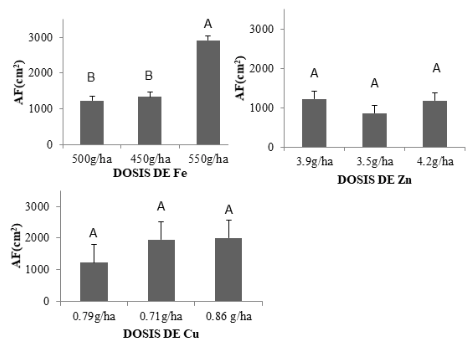
Figure 1 Effect of different doses of Fe, Zn and Cu on the leaf area (AF) in tomato cultivation. The different literals on the standard error bar, between levels of the same element, indicate significant difference according to the LSD test (p≤ 0.05).
The foliar area ratio (RAF) between the treatments was statistically different in the Fe and Zn doses, the high iron doses exceeded the control 112% (Figure 2), indicating that an excess of Fe generates a reduction in growth and this it will depend on the concentrations in the solution, on the other hand the high doses of Zn were higher 50%; however, other results indicate that an excess of Zn causes a decrease of dry matter in the plant (Casierra et al., 2010), causing a reduction in biomass production (Rizwan et al., 2017), while the doses of Cu were statistically similar, Yruela (2005), points out that excess concentrations of Cu inhibits growth, causing alterations in physiological processes such as photosynthesis and respiration, generating a reduction in crop biomass.
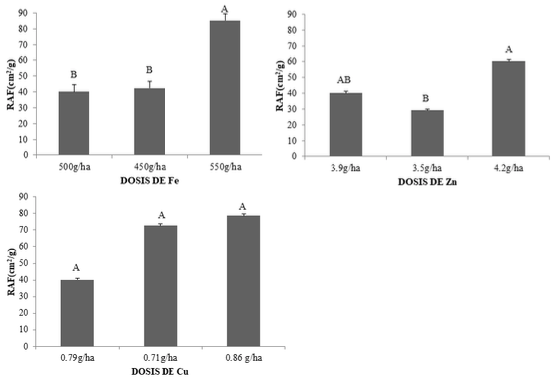
Figure 2 Effect of different doses of Fe, Zn and Cu on the leaf area ratio (RAF) in tomato cultivation. The different literals on the standard error bars, between levels of the same element, indicate significant difference according to the LSD test (p≤ 0.05).
For the specific leaf area (AFE), the high doses of Fe and Zn exceeded the control with 44% and 73%, respectively, while in the doses of Cu there were no significant differences (Figure 3), from high doses to means (control) for Fe and Zn there was a decrease in AFE. According to Santos et al. (2010) the decrease may be due to morphological changes that determine the formation of small and thick leaves, meanwhile Lizarazo et al. (2013) found that their treatments with Zn deficiency and excess were not significant differences, and they mention that in plants with Zn deficiency or excess their leaves are thin. On the other hand, Ghasemian et al. (2010) mention that with the application of 50 kg h-1 Fe increased significantly the number of pods, pod weight and biomass production in the Glycine max crop.
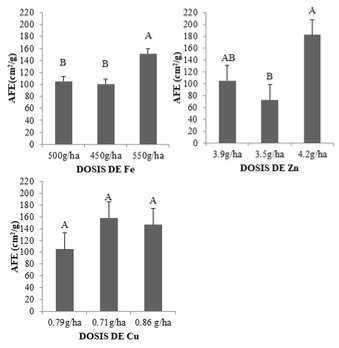
Figure 3 Effect of different doses of Fe, Zn and Cu on the specific leaf area (AFE) in tomato cultivation. Different literals on the standard error bars, between levels of the same element, indicate significant difference according to the LSD test (p≤ 0.05).
In the leaf weight ratio (RPF) all treatments were statistically similar (Figure 4), in this same variable he found that at the beginning of the crop cycle in Pisum sativum there were no differences; however, at the end of the cycle there was a difference where the doses of 2 mg L-1 were higher.
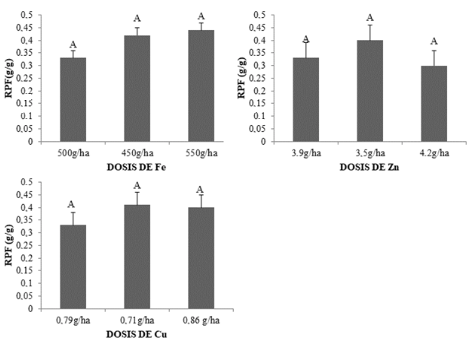
Figure 4 Effect of different doses of Fe, Zn and Cu on the leaf weight ratio (RPF) in tomato cultivation. Different literals on the standard error bars, between levels of the same element, indicate significant difference according to the LSD test (p≤ 0.05).
The variable leaf area index (IAF) treatment with 550 kg ha-1 of Fe (high dose) was 101% higher than the control, so it can be shown that high doses of Fe took advantage of the radiation present. According to Barraza et al. (2004) the increase in the IAF is physiologically manifested in a higher rate of photo translocation assimilated towards the demand points. There were no statistical differences in the doses of Zn and Cu (Figure 5).
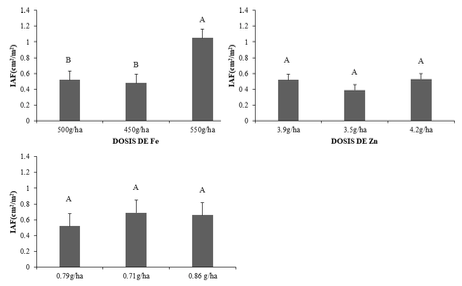
Figure 5 Effect of different doses of Fe, Zn and Cu on the leaf area index (IAF) in tomato cultivation. Different literals on the standard error bars, between levels of the same element, indicate significant difference according to the LSD test (p≤ 0.05).
The crop growth rate (TCC) (Figure 6) that indicates the productive efficiency of the biomass per unit of surface area occupied (soil) over time (Santos et al., 2010) in the present work were statistically similar, Pingoliya et al. (2014) mention that the application of 2 kg ha-1 of ferrous sulfate increased the biomass, production and yield of Cicer arietinum.
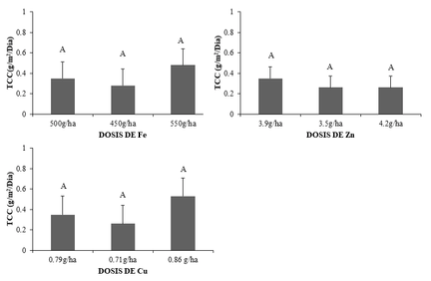
Figure 6 Effect of different doses of Fe, Zn and Cu on the growth rate of the crop (TCC) in tomato cultivation. Different literals on the standard error bars, between levels of the same element, indicate significant difference according to the LSD test (p≤ 0.05).
The yield with the Fe and Zn doses did not show statistical differences, the Fe in the 450 g doses has reported a higher yield with 28 t ha-1 compared to the control (Figure 7), different results were presented in the Vigna radiata culture where doses of 5 kg ha-1 of Fe contributed to maximum yield (Jamal et al., 2018).
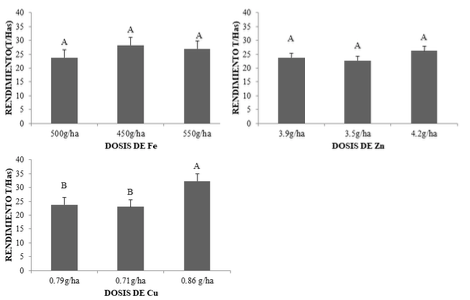
Figure 7 Effect of different doses of Fe, Zn and Cu on tomato crop yield. Different literals on the standard error bar, between levels of the same element, indicate significant difference according to the LSD test (p≤ 0.05).
The doses of Cu there were statistical differences, where the high doses were superior to the control 36%, different values when applying Fe, Cu and Zn in L. esculentum observed that the best yields were found with the doses of Zn followed by Cu exceeding to the control 20% and 4% respectively, on the other hand Patil et al. (2008) when applying Fe, Cu and Zn at 100 ppm, they found that Fe provided the best yields with 18.25 t ha-1, followed by Zn with 17.57 t ha-1 and finally Cu with 15.58 t ha-1 in L. esculentum. In this work, the lowest yields were found with the low doses of Zn.
In the Table 6 shows the values of the foliar area, RAF, AFE, RPF, IAF and performance variables. High doses of Fe and Cu showed the highest foliar areas with respect to the control in 137% and 63%, respectively, similar values were reported by El-Fouly et al. (2001) who demonstrated that at concentrations of 33.6 ppm of Fe (considered high doses) the leaf area was greater in Helianthus annus.
Table 6 Effect of Fe, Cu and Zn on the variables of biomass production and yield.
| Treatment | AF | RAF | AFE | RPF | IAF | TCC | REND |
| (cm2) | (cm2 g-1) | (cm2 g-1) | (g g-1) | (cm2 cm-2) | (g m-2 día-1) | (t ha-1) | |
| Control | 1225.82 bcZ | 34.79 b | 105.34 bc | 0.33 ab | 0.52 b | 0.35 a | 23.79 b |
| 450 g ha-1 Fe | 1332.35 bc | 40.97 ab | 100.87 bc | 0.42 ab | 0.48 b | 0.28 a | 28.23 ab |
| 550 g ha-1 Fe | 2 917. 18 a | 66. 45 a | 151.63 ab | 0. 44 a | 1.05 a | 0.48 a | 26.93 ab |
| 3.5 g ha-1 Zn | 867.92 c | 28.16 b | 73.14 c | 0.4 ab | 0.39 b | 0.26 a | 22.72 b |
| 4.2 g ha-1 Zn | 1 182.41 bc | 52.88 ab | 182. 72 a | 0.3 b | 0.53 b | 0.26 a | 26.19 ab |
| 0.71 g ha-1 Cu | 1 954.04 ab | 66. 6 a | 157.9 ab | 0.41 ab | 0.69 ab | 0.26 a | 22.9 8b |
| 0.86 g ha-1 Cu | 2 003.8 ab | 57.01 ab | 146.73 ab | 0.4 ab | 0.66 b | 0.53 a | 32.37 a |
| EE | 353.37 | 10.29 | 25.07 | 0.04 | 0.12 | 0.15 | 267 |
Z= means with the same letter are equal according to the LSD test at p≤ 0.05; EE= standard error; AF= leaf area; RAF= leaf area ratio; AFE= specific leaf area; RPF= leaf weight ratio; IAF= leaf area index; TCC= crop growth rate; REND= yield; Fe= iron; Cu= copper; Zn= zinc.
Low doses of Cu and high doses of Fierro increased RAF by 91%. Similar results were reported by Vinit-Dunand et al. (2002) who point out that the application of Cu at low concentrations provided a greater ratio of leaf area compared to high doses (10 mg g-1 substrate) in Cucumis sativus.
In the specific leaf area, high doses of Zn and low doses of Cu exceeded the control with 73 and 49%, respectively, Rouphael et al. (2008), when applying Cu, they found that at a higher concentration, less specific leaf area, with doses of 0.3, 47 and 94 µM, observed an AFE of 273.2, 256.8 and 238.3 cm2 g-1, respectively, in Cucumis sativus.
In the RPF variable, high doses of Fe exceeded the control 33%, while in the IAF the high doses of Fe and low doses of Cu exceeded the control by 101 and 32%, respectively, Caliskan et al. (2008) showed that the application of 0, 200 and 400 g ha-1 of Fe at the beginning of flowering in Glycine max the IAF was not significant, however, the effects were notable in the full pod stage, and the values of IAF increased significantly with high doses of Fe (400 g ha-1).
In performance it was superior with high doses of Cu, followed by low doses of Fe, which exceeded the control with 5 t, different results were found by Kumar et al. (2009) when applying different doses of Cu in Triticum aestivum, the highest yield was in the doses of 1.5 mg kg-1 of soil surpassing the control by 62.9% while, that the high doses presented lower yield than the control.
Conclusions
High doses of the microelements increased the variables of tomato fruit quality, especially total soluble solids, firmness and pH, although without statistical differences, on the other hand, low doses of Zn increased vitamin C; however, the values of AF, RAF, AFE, IAF and performance decreased. High doses of Fe improved the AF, IAF and PRF variables. Doses of high Cu favored performance and TCC. The deficiency of the Fe, Cu and Zn microelements limited the leaf area, while high doses improved the IAF and yield.
Literatura citada
Álvarez, F. A.; Paniagua, P.; Abadía, J. and Abadía, A. 2003. Effects of Fe deficiency chlorosis on yield and fruit quality in peach (Prunus persica L. Batsch). J. Agric. Food Chem. 51(19):5738-5744. [ Links ]
Barraza, F. V.; Gerhard, F. y Cardona, C. E. 2004. Estudio del proceso de crecimiento del cultivo del tomate. Agron. Colomb. 22(1):81-90. [ Links ]
Briat, J. F.; Dubos, C. and Gaymard, F. 2015. Iron nutrition, biomass production, and plant product quality. Trends Plant Sci. 20(1):33-40. [ Links ]
Caliskan, S.; Ozkaya, I.; Caliskan, M. E. and Arslan, M. 2008. The effects of nitrogen and iron fertilization on growth, yield and fertilizer use efficiency of soybean in a Mediterranean-type soil. Field Crops Res. 108(2):126-132. [ Links ]
Casierra, P. F.; González, L. A. y Ulrichs, C. 2010. Crecimiento en plantas de brócoli (Brassica oleracea L. var. Itálica) afectadas por exceso por Zinc. Rev. Colomb. Cienc. Hortíc. 4(2):166-174. [ Links ]
Castro, K.; Restrepo, M. L.; Ocampo, G. T. y Quintero, G. A. 2009. Intensidad de los sabores básicos del tomate (Lycopersicon esculentum) en seis estados de madurez. Biotecnología en el Sector Agropecuario y Agroindustrial (BSAA). 7(1):23-28. [ Links ]
Eberhard, S.; Finazzi, G. and Wollman, F. A. 2008. The dynamics of photosynthesis. Annual Review of Genetics. 1(42): 463-515. [ Links ]
El‐Fouly, M. M.; Nofal, O. A. and Mobarak, Z. M. 2001. Effects of soil treatment with iron, manganese and zinc on growth and micronutrient uptake of sunflower plants grown in high‐pH soil. J. Agron. Crop Sci. 186(4):245-251. [ Links ]
Ghasemian, V.; Ghalavand, A.; Soroosh, Z. A. and Pirzad, A. 2010. The effect of iron, zinc and mangnese on quality and quantity of soybean seed. J. Phytol. 2(11):73-79. [ Links ]
Haleema, B.; Rab, A. and Hussain, S. A. 2018. Effect of calcium, boron and zinc foliar application on growth and fruit production of tomato. Sarhad J. Agric. 34(1):19-30. [ Links ]
Incesu, M.; Yeşiloğlu, T.; Cimen, B. and Yilmaz, B. 2015. Influences of different iron levels on plant growth and photosynthesis of W. Murcott mandarin grafted on two rootstocks under high pH conditions. Turkish J. Agric. Forest. 39(5):838-844. [ Links ]
Jamal, A.; Khan, M. I.; Tariq, M. and Fawad, M. 2018. Response of mung bean crop to different levels of applied iron and zinc. J. Hortic. Plant Res. 3(4):13-22. [ Links ]
Kumar, R.; Mehrotra, N. K.; Nautiyal, B. D.; Kumar, P. and Singh, P. K. 2009. Effect of copper on growth, yield and concentration of Fe, Mn, Zn and Cu in wheat plants (Triticum aestivum L.). J. Environ. Biol. 30(4):485-488. [ Links ]
Kyrkby, E. y Römheld, V. 2008. Micronutrientes en la fisiología de las plantas: funciones, absorción y movilidad. Informaciones agronómicas. Encarte técnico. 118:1-24. [ Links ]
Lin, M. Z. and Jin, M. F. 2018. Soil Cu contamination destroys the photosynthetic systems and hampers the growth of green vegetables. Photosynthetica. 56(4):1336-1345. [ Links ]
Lizarazo, M. Á.; Hernández, C. A.; Fischer, G. y Gómez, M. I. 2013. Biomasa, parámetros foliares y sintomatología en respuesta a diferentes niveles de manganeso, zinc y boro en curuba (Passiflora tripartita var. mollissima). Rev. Colomb. Cienc. Hortíc. 7(1):31-45. [ Links ]
López, H. A.; Castillo, G. A. M.; Trejo, T. L. I.; Avitia, G. E. y Valdez, A. L. A. 2018. Respuesta de fresa cv. Albión a dosis crecientes de Zinc. Rev. Mex. Cienc. Agríc. 9(8):1591-1601. [ Links ]
Patil, B. C.; Hosamani, R. M.; Ajjappalavara, P. S.; Naik, B. H., Smitha, R. P. and Ukkund, K. C. 2008. Effect of foliar application of micronutrients on growth and yield components of tomato (Lycopersicon esculentum Mill.). Karnataka J. Agric. Sci. 21(3):428-430. [ Links ]
Perea, P. E.; Ojeda, B. D. L.; Hernández, R. O. A.; Escudero, A. D. J.; Martínez, T. J. J. y López, O. G. R. 2010. El zinc como promotor de crecimiento y fructificación en el nogal pecanero. Tecnociencia Chihuahua. 4(2):64-71. [ Links ]
Pingoliya, K. K.; Dotaniya, M. L. and Lata, M. 2014. Effect of iron on yield, quality and nutrient uptake of chickpea (Cicer arietinum L.). Afr. J. Agric. Res. 9(37):2841-2845. [ Links ]
Rizwan, M.; Ali, S.; Hussain, A.; Ali, Q.; Shakoor, M. B.; Zia-ur, R. M. and Asma, M. 2017. Effect of zinc-lysine on growth, yield and cadmium uptake in wheat (Triticum aestivum L.) and health risk assessment. Chemosphere. 187(5):35-42. [ Links ]
Rouphael, Y.; Cardarelli, M.; Rea, E. and Colla, G. 2008. Grafting of cucumber as a means to minimize copper toxicity. Environ. Exp. Bot. 63(1-3):49-58. [ Links ]
Rui, M.; Ma, C.; Hao, Y.; Guo, J.; Rui, Y., Tang, X. and Zhu, S. 2016. Iron oxide nanoparticles as a potential iron fertilizer for peanut (Arachis hypogaea). Frontiers in Plant Sci. 815(7):01-10. [ Links ]
Santos, C. M.; Segura, A. M. y Ñústez, L. C. E. 2010. Análisis de crecimiento y relación fuente-demanda de cuatro variedades de papa (Solanum tuberosum L.) en el municipio de Zipaquirá (Cundinamarca, Colombia). Rev. Facultad Nacional de Agronomía-Medellín. 1(63):5253-5266. [ Links ]
Sathiyamurthy, V. A.; Shanmugasundaram, T.; Rajasree, V. and Arumugam, T. 2017. Effect of Foliar Application of Micronutrients on Growth, Yield and Economics of Tomato (Lycopersicon esculentum Mill.). Madras Agric. J. 104 (4-6):188-193. [ Links ]
Soetan, K. O.; Olaiya, C. O. and Oyewole, O. E. 2010. The importance of mineral elements for humans, domestic animals and plants-A review. Afr. J. Food Sci. 4(5):200-222. [ Links ]
Valentinuzzi, F.; Mason, M.; Scampicchio, M.; Andreotti, C.; Cesco, S. and Mimmo, T. 2015. Enhancement of the bioactive compound content in strawberry fruits grown under iron and phosphorus deficiency. J. Sci. Food Agric. 95(10):2088-2094. [ Links ]
Vinit-Dunand, F.; Epron, D.; Alaoui-Sossé, B. and Badot, P. M. 2002. Effects of copper on growth and on photosynthesis of mature and expanding leaves in cucumber plants. Plant Sci. 163(1):53-58. [ Links ]
Yruela, I. 2005. Copper in plants. Braz. J. Plant Physiol. 17(1):145-156. [ Links ]
Received: June 01, 2019; Accepted: August 01, 2019











 texto em
texto em 


